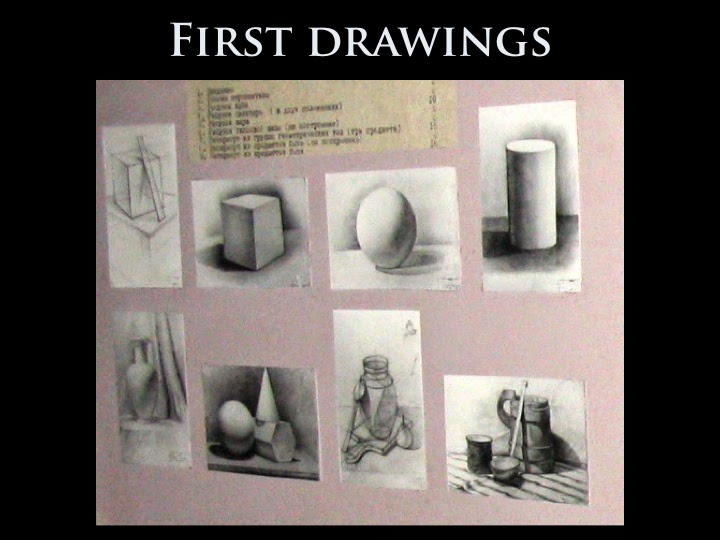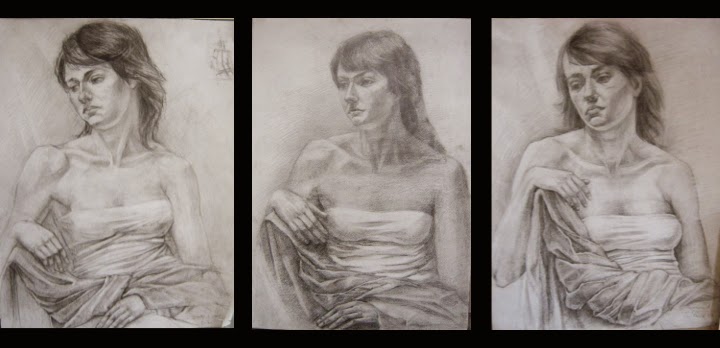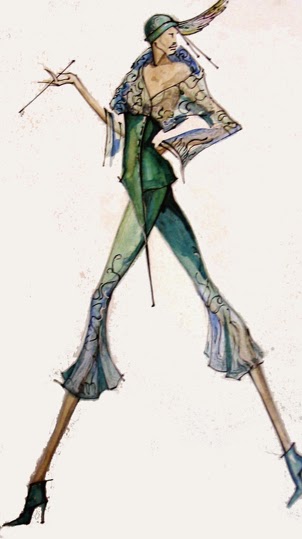Art Education and the Trivium
The book, The Question: Teaching Your Child the Essentials of Classical Education by Leigh A. Bortins, is a refreshing read, and I highly recommend the book to anyone--parent or teacher--who has children to teach.
The Question is not only about learning to ask good questions, but also about the core structure of classical education, the trivium. And what is that core? A sequence of three steps.
-
Grammar. In this first step, we learn the vocabulary and rules of a given field.
-
Dialectic. Students learn to process new concepts and communicate clearly.
-
Rhetoric.Students learn the art of being persuasive.
The process the trivium uses to make students skilled in expressive, meaningful communication is similar to the process of learning to make expressive, meaningful visual art.


The most exciting example I have found that demonstrates how the training of an artist mirrors the pattern of the trivium has been the work of the drawing and painting teachers at the Artistic Theatrical College in Odessa, Ukraine. Beginning students are first taught the foundations of a visual grammar:
-
They draw and shade simple geometric shapes,
-
They shade organic shapes, like folded fabric, and
-
They learn to use color mixing to paint simple still lifes.
In the "dialectic" stage of their training, they apply the "grammar" of visual art as they draw plaster casts of the human form--noses, hands, limbs, and trunks. Soon they are able to draw live models so photographically that the only differences between different students' rendering of the same figure is the position from which they viewed the subject.
|

|
|
Three drawings of the same model by three students from the Artistic Theatrical College
|
In the "rhetorical" stage, they are able to use the skills they have acquired in the first two stages to make expressive, meaningful designs.

But notice that the final stage was preceded by carefully tending to the grammar of art--the principles of shading, the principles of color theory, of composition, etc.
Leigh A. Bortins says that "Lifelong learners are always in grammar school." It's true. I follow the process from the grammar stage to the rhetorical as I develop every lesson at ArtAchieve. If I'm working on a lesson that combines one-point perspective and pointillism into one lesson, I have to relearn the grammar rules of one-point perspective (where DOES one place the vanishing point?) and I have to learn Seurat's use of color theory in his revolutionary, dotted paintings before I can complete the lesson.
It's also a process that students follow as they learn art through ArtAchieve's art lessons for kids. In Level I lessons they are learning to use media, and they are learning to draw simple figures. By Level III, they are drawing complex compositions, like The African Crowned Crane, or The Eastern European Firebird. And by Level V, they are learning to use what they have learned as they begin to imitate artistic styles: Impressionism, Art Deco, Primitivism, etc.
The trivium helps students learn the grammar before they try their hand at being expressive. If your child likes to draw, but doesn't seem to get past a certain stage or style of drawing, think back to the trivium: What stage might be missing in his/her training?
Get started in art lessons for kids with these free art lessons today!
The book, The Question: Teaching Your Child the Essentials of Classical Education by Leigh A. Bortins, is a refreshing read, and I highly recommend the book to anyone--parent or teacher--who has children to teach.
The Question is not only about learning to ask good questions, but also about the core structure of classical education, the trivium. And what is that core? A sequence of three steps.
-
Grammar. In this first step, we learn the vocabulary and rules of a given field.
-
Dialectic. Students learn to process new concepts and communicate clearly.
-
Rhetoric.Students learn the art of being persuasive.
The process the trivium uses to make students skilled in expressive, meaningful communication is similar to the process of learning to make expressive, meaningful visual art.


The most exciting example I have found that demonstrates how the training of an artist mirrors the pattern of the trivium has been the work of the drawing and painting teachers at the Artistic Theatrical College in Odessa, Ukraine. Beginning students are first taught the foundations of a visual grammar:
-
They draw and shade simple geometric shapes,
-
They shade organic shapes, like folded fabric, and
-
They learn to use color mixing to paint simple still lifes.
In the "dialectic" stage of their training, they apply the "grammar" of visual art as they draw plaster casts of the human form--noses, hands, limbs, and trunks. Soon they are able to draw live models so photographically that the only differences between different students' rendering of the same figure is the position from which they viewed the subject.
|

|
|
Three drawings of the same model by three students from the Artistic Theatrical College
|
In the "rhetorical" stage, they are able to use the skills they have acquired in the first two stages to make expressive, meaningful designs.

But notice that the final stage was preceded by carefully tending to the grammar of art--the principles of shading, the principles of color theory, of composition, etc.
Leigh A. Bortins says that "Lifelong learners are always in grammar school." It's true. I follow the process from the grammar stage to the rhetorical as I develop every lesson at ArtAchieve. If I'm working on a lesson that combines one-point perspective and pointillism into one lesson, I have to relearn the grammar rules of one-point perspective (where DOES one place the vanishing point?) and I have to learn Seurat's use of color theory in his revolutionary, dotted paintings before I can complete the lesson.
It's also a process that students follow as they learn art through ArtAchieve's art lessons for kids. In Level I lessons they are learning to use media, and they are learning to draw simple figures. By Level III, they are drawing complex compositions, like The African Crowned Crane, or The Eastern European Firebird. And by Level V, they are learning to use what they have learned as they begin to imitate artistic styles: Impressionism, Art Deco, Primitivism, etc.
The trivium helps students learn the grammar before they try their hand at being expressive. If your child likes to draw, but doesn't seem to get past a certain stage or style of drawing, think back to the trivium: What stage might be missing in his/her training?
Get started in art lessons for kids with these free art lessons today!
The book, The Question: Teaching Your Child the Essentials of Classical Education by Leigh A. Bortins, is a refreshing read, and I highly recommend the book to anyone--parent or teacher--who has children to teach.
The Question is not only about learning to ask good questions, but also about the core structure of classical education, the trivium. And what is that core? A sequence of three steps.
-
Grammar. In this first step, we learn the vocabulary and rules of a given field.
-
Dialectic. Students learn to process new concepts and communicate clearly.
-
Rhetoric.Students learn the art of being persuasive.
The process the trivium uses to make students skilled in expressive, meaningful communication is similar to the process of learning to make expressive, meaningful visual art.


The most exciting example I have found that demonstrates how the training of an artist mirrors the pattern of the trivium has been the work of the drawing and painting teachers at the Artistic Theatrical College in Odessa, Ukraine. Beginning students are first taught the foundations of a visual grammar:
-
They draw and shade simple geometric shapes,
-
They shade organic shapes, like folded fabric, and
-
They learn to use color mixing to paint simple still lifes.
In the "dialectic" stage of their training, they apply the "grammar" of visual art as they draw plaster casts of the human form--noses, hands, limbs, and trunks. Soon they are able to draw live models so photographically that the only differences between different students' rendering of the same figure is the position from which they viewed the subject.
|

|
|
Three drawings of the same model by three students from the Artistic Theatrical College
|
In the "rhetorical" stage, they are able to use the skills they have acquired in the first two stages to make expressive, meaningful designs.

But notice that the final stage was preceded by carefully tending to the grammar of art--the principles of shading, the principles of color theory, of composition, etc.
Leigh A. Bortins says that "Lifelong learners are always in grammar school." It's true. I follow the process from the grammar stage to the rhetorical as I develop every lesson at ArtAchieve. If I'm working on a lesson that combines one-point perspective and pointillism into one lesson, I have to relearn the grammar rules of one-point perspective (where DOES one place the vanishing point?) and I have to learn Seurat's use of color theory in his revolutionary, dotted paintings before I can complete the lesson.
It's also a process that students follow as they learn art through ArtAchieve's art lessons for kids. In Level I lessons they are learning to use media, and they are learning to draw simple figures. By Level III, they are drawing complex compositions, like The African Crowned Crane, or The Eastern European Firebird. And by Level V, they are learning to use what they have learned as they begin to imitate artistic styles: Impressionism, Art Deco, Primitivism, etc.
The trivium helps students learn the grammar before they try their hand at being expressive. If your child likes to draw, but doesn't seem to get past a certain stage or style of drawing, think back to the trivium: What stage might be missing in his/her training?
Get started in art lessons for kids with these free art lessons today!







